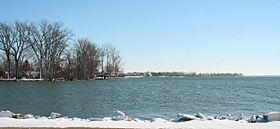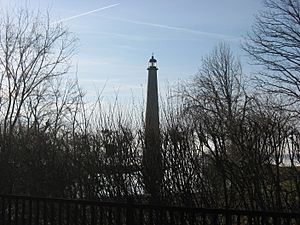Grand Lake St. Marys State Park facts for kids
Quick facts for kids Grand Lake St. Marys State Park |
|
|---|---|

Sunset over Grand Lake St. Marys
|
|
| Lua error in Module:Location_map at line 420: attempt to index field 'wikibase' (a nil value). | |
| Location | Mercer and Auglaize counties, Ohio, United States |
| Area | Land: 591 acres (239 ha) Water: 13,500 acres (5,500 ha) |
| Elevation | 869 ft (265 m) |
| Established | 1949 |
| Administered by | Ohio Department of Natural Resources |
| Designation | Ohio state park |
| Named for | Grand Lake and St. Marys |
| Website | Grand Lake St. Marys State Park |
| Grand Lake | |
|---|---|
 |
|
| Location | Mercer / Auglaize counties, Ohio, United States |
| Coordinates | 40°31′36″N 84°30′03″W / 40.52667°N 84.50083°W |
| Type | Artificial lake |
| Primary inflows | Coldwater Creek |
| Primary outflows | Beaver Creek |
| Basin countries | United States |
| Max. length | 8.2 mi (13.2 km) |
| Max. width | 2.8 mi (4.5 km) |
| Surface area | 12,896 acres (5,219 ha) |
| Average depth | 5–7 ft (1.5–2.1 m) |
| Shore length1 | 74 mi (119 km) |
| Surface elevation | 871 ft (265 m) |
| Islands | Safety Island |
| 1 Shore length is not a well-defined measure. | |

Grand Lake St. Marys State Park is a fun place for everyone to visit! It's located in Mercer and Auglaize counties, Ohio, right on the huge Grand Lake. Grand Lake is the biggest lake inside Ohio, covering about 13,500 acres (5,500 ha). But it's not very deep, usually only about 5–7 feet (1.5–2.1 m).
You can visit the park all year long for exciting activities like boating, fishing, swimming, and even hunting. The park includes the lake itself and many different areas along its shores. Some parts are private property, and there's also a special facility run by Wright State University. The park is located west of St. Marys and southeast of Celina. It's about 23 miles (37 km) southwest of Lima in the northwestern part of Ohio.
Contents
History of Grand Lake St. Marys
Grand Lake St. Marys was built a long time ago, in the early 1800s. It was made to be a giant water storage area, called a reservoir, for the Miami and Erie Canal. This canal was super important because it connected the Ohio River all the way to Lake Erie.
At one point, Grand Lake was the biggest man-made lake in the entire world! The canal system was very busy for about 30 years in the mid-to-late 1800s. But then, railroads came along and took over, making the canals less important.
Oil Discovery and First Offshore Drilling
In the 1890s, something exciting happened: oil was found in the area! Around 1891, oil derricks (those tall structures used to drill for oil) were set up right in the lake. This made Grand Lake the very first place in the world to have offshore oil drilling.
The lake officially became one of Ohio's first state parks in 1949. Over the next few years, many fun places and facilities were built for visitors to enjoy.
Different Names for the Lake
The official name of the lake is just "Grand Lake." The U.S. government's geographic board actually said no to changing the name to "Grand Lake-Saint Marys," even though that's what you might see on some state maps.
Back in 1920, an encyclopedia even called it "Lake Mercer" on its map of Ohio. People also started calling it "Lake St. Marys" in the early 1900s, but folks in Celina didn't really like that name. Over time, the lake has also been known as "Grand Reservoir" and "Lake Celina," among other names.
Nature and Wildlife at the Park
The land where Grand Lake St. Marys is now used to be part of a huge forest. This forest stretched all the way from the Appalachian Mountains in Pennsylvania to the prairie in Illinois. But as pioneer farmers settled the area after the Northwest Indian War, they cleared much of the forest. Now, you'll mostly see farms with fields of wheat, soybeans, and corn.
Before the lake was built, this area was a swampy prairie. When the lake was created in the early 1800s, the prairie became flooded. Today, the lake's shore has different types of nature, including woodlands, wet areas (wetlands), and small prairie spots. These natural areas are surrounded by homes and farms.
You can even find some special trees called eastern hemlocks around the lake. These are the westernmost natural groups of these trees in all of Ohio!
Birds and Other Animals
Grand Lake St. Marys is a very important stop for migratory birds that fly long distances. You'll often see different kinds of waterfowl like geese, loons, ducks, grebes, and swans. In the marshy areas, you might spot wading birds like egrets and herons.
For almost ten years, American white pelicans have been seen at the park every year! These large birds used to only breed in the western U.S. and Canada, but now they seem to be spreading eastward. In 2019, white pelican nests were even found on Lake Erie for the first time.
Other birds you might see include cormorants, red-tailed hawks, and ospreys. There are also several types of owls, such as great horned owls, barred owls, screech owls, and saw-whet owls. Very rarely, you might even spot a snowy owl! The bald eagle, which was once endangered, has made a comeback in the area, and there are several nests around the lake.
The most common mammals you'll find in the park are cottontail rabbits, mink, fox squirrels, white-tailed deer, eastern coyotes, beavers, muskrats, and raccoons.
Environmental Concerns and Lake Health
Grand Lake St. Marys has faced some challenges with pollution. There have been high levels of E. coli bacteria and algae, which can make the lake unhealthy. The Ohio Environmental Protection Agency says the lake is "impaired" because of things like changes to streams, drainage from farms, and pollution from failing home septic systems and small towns without proper wastewater treatment.
One of the biggest problems comes from runoff from farmland. Water flowing off farms can carry nutrients from livestock waste and fertilizers. These nutrients, especially phosphorus and nitrogen, can upset the lake's natural balance. They cause too much blue-green algae to grow.
This algae is actually a type of bacteria called cyanobacterium. A specific kind, Planktothrix, is particularly troublesome. These bacteria can produce harmful substances called peptides that can hurt plants and animals. Humans can also be affected. For example, a substance called Microcystin can make people sick, causing rashes, sneezing, or even stomach problems.
Farm runoff isn't the only source of pollution. Water from factories and businesses, as well as old septic tanks and city sewage systems, also contribute to the problem.
Heavy amounts of silt (fine dirt) also flow into the lake, making it less healthy. When homes are built along the shore, it often means fewer native plants are left. These native plants are important because they help hold the soil and stop erosion. More homes can also mean more phosphates enter the lake from lawn fertilizers, which directly helps the algae grow even more. The natural plants that used to be there helped filter out these extra nutrients.
Fun Activities at Grand Lake St. Marys
Grand Lake St. Marys State Park is open all year long for lots of fun activities! You can go boating, hunting, fishing, swimming, and have picnics.
Camping and Boating
The park has a large campground with 216 sites, and 135 of them have electricity. There are modern restrooms, a laundry area, and a place to empty RV tanks. You can even bring your pets to the campground!
Grand Lake St. Marys is great for boating, fishing, swimming, and water skiing. Boats with any amount of horsepower are allowed on the lake. The state has nine different ramps where you can launch your boat. There's a special 300-foot (91 m) "no-wake zone" around the lake's 52 miles (84 km) of shore, which means boats must go slowly there. Boats are not allowed in a special wildlife refuge area in the southwest corner of the lake.
Fishing and Hunting
You can fish in the lake all year round. Some common fish you might catch include crappie, bass, yellow perch, and bluegill.
Hunting is allowed in certain areas of the park. Grand Lake St. Marys is home to many different kinds of waterfowl (birds that live on water). The state owns seventy duck blinds, which are special shelters for hunters, located in the hunting zones.
Swimming and Other Fun
There are four public swimming beaches at the park, plus other swimming spots for boaters. However, since 2010, the water has sometimes been unsafe for swimming, and beaches may be closed for safety.
The park also has several picnic areas and shelters where you can enjoy a meal outdoors.
At the camp store, you can borrow games, fishing gear, and sports equipment if you're a registered camper. You can also rent bikes at the campground. The park has a miniature golf course, basketball and volleyball courts, horseshoe pits, playground equipment, and even a swimming pool that was recently added!
Fish Hatchery and Seaplane Base
The St. Marys Fish Hatchery is located on the eastern side of the lake. It's run by the Ohio Department of Natural Resources (ODNR) Division of Wildlife. This hatchery raises fish like saugeye, walleye, channel catfish, and bass. These fish are then released into public fishing waters across the state to help keep fish populations healthy.
The Grand Lake St. Marys Seaplane Base also operates on the lake. It's the only airport in Ohio specifically for seaplanes, which are planes that can land and take off on water!
Images for kids





